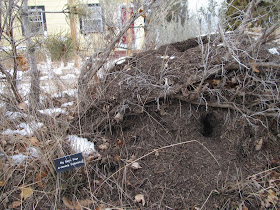Our goal is to make our garden our feeder by planting native plants and providing habitat and this sustains a variety of birds, insects and other wildlife. This has been our goal, and even in a small, city lot, you can have success.
Our giant ant hill in our front yard is a Northern flicker's favorite. Through the winter, flickers dig this up for tasty grubs (and defenseless slow moving adults in the cold).
In winter, we add some feeders for birds, but not the typical ones people are used to seeing, though non-traditional feeders, yet they are more natural. for example, my favorite, carcasses.
These parts and pieces are left overs from butchering our game meat during hunting season.
Although the aesthetic might not be for everyone, carcasses (from winterkill, and predator kills) are the original suet feeder (click here for more information).
Even a little scapula can be an enticing feeder for chickadees, nuthatches, flickers, and downy woodpeckers.
In addition to providing housing for native solitary nesting bees, mason bee boxes, aka "larvae feeders" provide food for nuthatches, downy woodpeckers and chickadees that pick the overwintering larvae out. Here a chickadee uses its wings for improved leverage to get one out









Whoa...that is quite the last photo. I've seen a few smaller birds get taken by hawks at our place. Its always a fascinating spectacle. I still have two standard feeders...but perhaps I should look into some alternatives. I do love watching the birds on the sunflowers more than at the feeder, say. They have to work for it and its more natural for them and interesting for me. No one in my household hunts...but I bet we could figure something out...
ReplyDeleteVery impressive! And you get some great bird pics.
ReplyDeleteHa! Thanks for explaining what emptied out the cells of my orchard bee condo complexes this fall! In future years I'll guard them with screening.
ReplyDelete